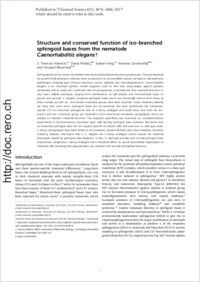Structure and conserved function of iso-branched sphingoid bases from the nematode Caenorhabditis elegans
- Hannich, J. Thomas Department of Biochemistry, University of Geneva, Switzerland - NCCR Chemical Biology, Switzerland
- Mellal, Denia Department of Chemistry, University of Fribourg, Switzerland - NCCR Chemical Biology, Switzerland
- Feng, Suihan Department of Biochemistry, University of Geneva, Switzerland - NCCR Chemical Biology, Switzerland
- Zumbuehl, Andreas Department of Chemistry, University of Fribourg, Switzerland - NCCR Chemical Biology, Switzerland
- Riezman, Howard Department of Biochemistry, University of Geneva, Switzerland - NCCR Chemical Biology, Switzerland
-
03.05.2017
Published in:
- Chemical Science. - 2017, vol. 8, no. 5, p. 3676–3686
English
Sphingolipids are bio-active metabolites that show structural diversity among eukaryotes. They are essential for growth of all eukaryotic cells but when produced in an uncontrolled manner can lead to cell death and pathologies including auto-immune reactions, cancer, diabetes and neurodegeneration. Caenorhabditis elegans is an important genetic model organism both to find new drug-targets against parasitic nematodes and to study the conserved roles of sphingolipids in animals like their essential functions in very basic cellular processes ranging from maintenance of cell polarity and mitochondrial repair to growth and survival. C. elegans produces sphingoid bases which are structurally distinct from those of other animals as both iso- and anteiso-branched species have been reported. Using metabolic labeling we show that most worm sphingoid bases are iso-branched. We have synthesized the nematode- specific C17 iso-branched sphinganine and its 1-deoxy analogue and could show that both the iso-branch and the 1-hydroxyl group are essential to form functional nematode sphingolipids which are needed to maintain intestinal function. The organism specificity was examined by complementation experiments in Saccharomyces cerevisiae yeast cells lacking sphingoid base synthesis. We found that iso-branched sphingoid base did not support growth of mutant cells and was toxic to wild type yeast. 1-Deoxy sphingolipids have been linked to the hereditary disease HSAN1A and other metabolic disorders including diabetes. We found that in C. elegans the 1-deoxy analogue cannot rescue the intestinal phenotype caused by sphingoid base depletion. In fact, in wild-type animals with normal sphingoid base biosynthesis, exogenous 1- deoxy analogue had a disruptive effect on apical cytoskeletal organization of intestinal cells indicating that atypical bases can interfere with normal sphingolipid function.
- Faculty
- Faculté des sciences et de médecine
- Department
- Département de Chimie
- Language
-
- English
- Classification
- Biological sciences
- License
-
License undefined
- Identifiers
-
- RERO DOC 288610
- DOI 10.1039/C6SC04831E
- Persistent URL
- https://folia.unifr.ch/unifr/documents/305385
Other files
Statistics
Document views: 123
File downloads:
- pdf: 144
- Supplementary material: 173

